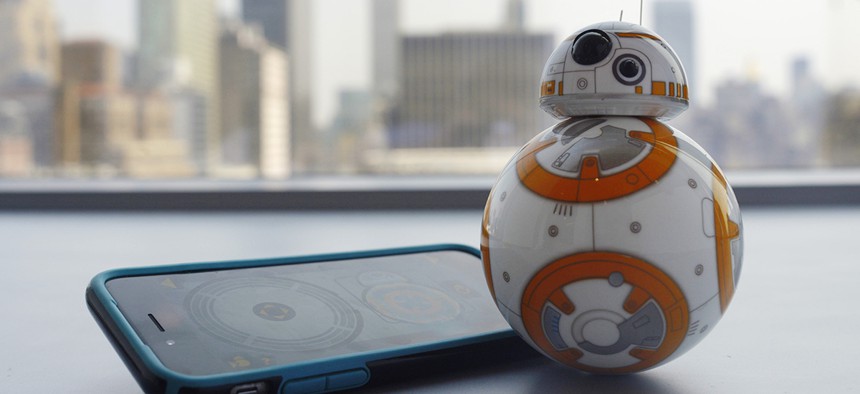We Need a New Pronoun for Artificial Intelligence

BB-8 and a smartphone. Patrick Sison/AP
Pick your favorite: “bleep” or “bloop.”
Deep inside a spaghetti bowl of suburban Maryland streets this weekend, I turned to a trusted guide for directions back to the highway. But this guide couldn’t figure out what direction we were going, and she asked me to perform nonsensical maneuvers.
“Actually, don’t listen to Siri—she can’t figure out where we are,” said a friend in the passenger seat.
Referring to Apple’s artificial-intelligence (AI) assistant as “she” feels natural because of Siri’s female-sounding voice. Although Siri herself will tell you she is neither male nor female—“I exist beyond your human concept of gender”—her relatively natural-sounding voice elicits a warmer response than a stilted robot voice would.
There’s an option buried in every iPhone to make Siri speak in a male-sounding voice (or in a British or an Australian accent), but Siri is not “he” by default for a reason: Research shows that people react more positively to female voices.
The quality of these digital assistants’ voices earns them a gendered pronoun—but what about AI that looks and sounds more like a robot? The iconic R2-D2, for example, speaks entirely in bleeps and bloops, but is referred to with a male pronoun throughout the "Star Wars" saga. The latest "Star Wars" droid, BB-8, is even less humanoid, rolling around on a smooth sphere. But he, too, has been assigned a gender, although his gender identity fluctuated during the production of "The Force Awakens."
The obvious alternative to calling a robot a he or a she is to refer to them as “it.” The pronoun certainly avoids the pitfalls of gendering AI—pitfalls that maintain the stereotype of the submissive female assistant, for example—but it renders the human-machine relationship in impersonal terms. This is everything an AI developer wants to avoid: Apple, for example, has tried to imbue Siri with character by programming the assistant with clever responses.
Often, a new technology that departs from the familiar will be designed in such away to make it look less foreign. Early iterations of iPhone operating systems, for example, mimicked real-world items—a yellow notepad, a calculator with shiny buttons—to help users understand how to interact with the alien plastic-and-glass slab in their hands.
After seven years of skeuomorphic design, perhaps assuming that it no longer needed to hold users’ hands, Apple shifted to the relatively inscrutable flat design it still uses today.
It could be that robots and AI that share qualities with humans—like a gender identity—are a similar design trick. These shared qualities help humans acclimate to the proliferation of AI without feeling overrun by metallic Terminators. Once it becomes commonplace, we may no longer need a familiar crutch—human gender pronouns—to refer to artificial intelligence.
When that happens, likely not too far in the future, we’ll need a new way to talk about computers. More than an “it,” but not quite a “he” or a “she,” AI is a new category of entity. But creating new pronouns is hard. Although many people prefer to be referred to using gender-neutral pronouns like “ze” rather than “him” or “her,” these pronouns haven’t caught on widely.
Meanwhile, popular culture is increasingly focused on the role of robots—and their gender—in our lives. Two recent films that have featured female AI characters have taken on the trope of an obedient, hapless Siri-like assistant. Samantha from "Her" and Ava from "Ex Machina" become sexualized romantic interests for male protagonists, fulfilling the fantasies of the lonely men that become obsessed with them. But in both films, the female AI get the better of their human suitors, leaving the men behind as they grow stronger.
But even Samantha and Ava are, in a way, stock female characters. Until we can conceive of a genderless intelligence, even a rolling sphere that pings and whirrs to communicate will be a “he,” with all the baggage and connotations that come with that word.



